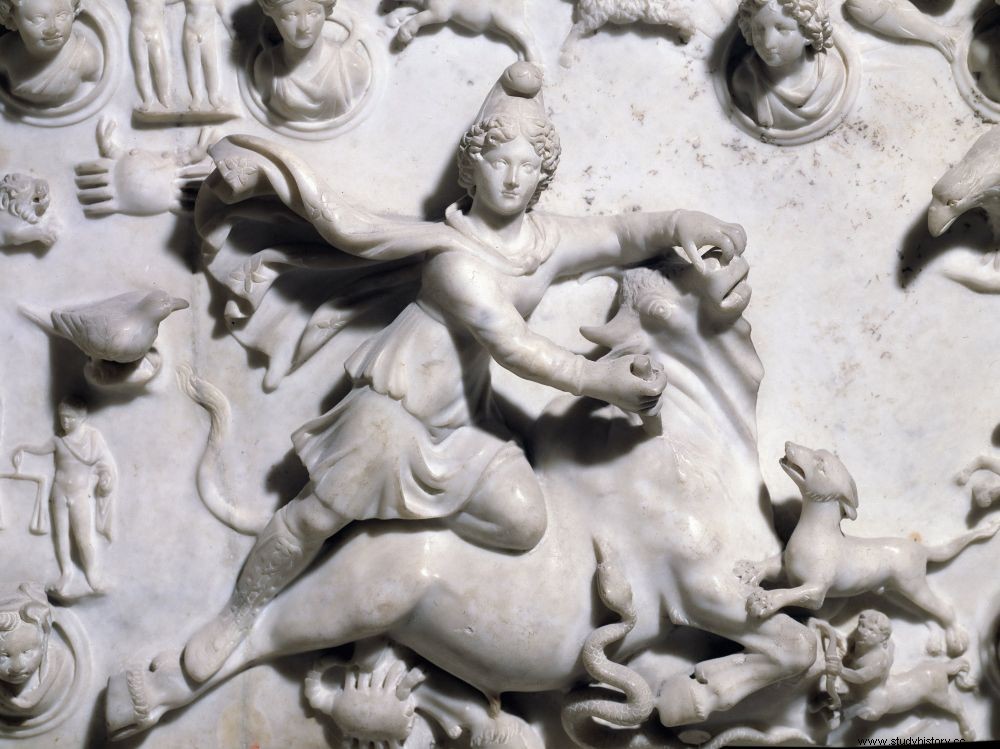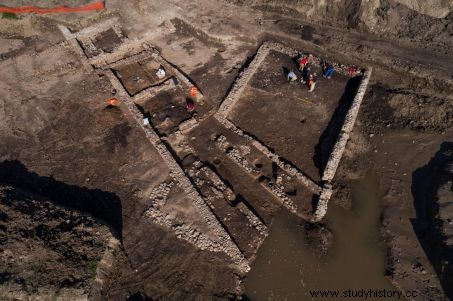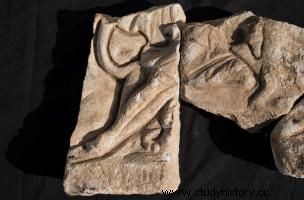A temple dedicated to the god Mithra has been unearthed in the ancient Roman colony of Mariana in Corsica. The explanations of the historian Nicole Belayche, specialist in mystery cults.

Bullfighting scene. Mithra immolating the bull. 2 th marble bas-relief -3 e century, from the Mithraeum of Sidon (Lebanon). Paris, Louvre Museum
This is a first in Corsica. A mithraeum , a "cave" sanctuary dedicated to Mithras, a deity of Indo-Iranian origin, was unearthed at Lucciana (Haute-Corse). These remains of a structure erected around the year 100 of our era, were in a peripheral district of the ancient Roman colony of Mariana, a small port agglomeration on the east coast of the island. This exceptional find is due to a team from the National Institute for Preventive Archaeological Research (Inrap), led by archaeologist Philippe Chapon. Indeed, only about ten of these sites of the Mithraic cult have so far been exhumed in France, in particular in the Rhone Valley and in the East, regions integrated in Antiquity into the provinces of Germania. Since November 2016, the remains of an antechamber and a large central nave have been excavated in Lucciana.

Aerial view of the mithraeum, sanctuary dedicated to Mithras, discovered in Lucciana, in Haute-Corse. © Denis Gliksman / Inrap
It is a hall of worship bordered by two long benches, at the end of which was to stand a marble sculpture representing the god Mithra. A few fragments have been collected by archaeologists, suggesting that the scene must illustrate tauroctony , a religious representation encountered in all the mithraea ( or mithrées) , showing the immolation of a bull by Mithras, the stone-born god (the pietra genitrix ) according to mythology.

Remains of a bullfighting scene found in the sanctuary of Mariana, the ancient Roman city of Lucciana, in Corsica, showing the immolation of a bull by Mithras. © Denis Gliksman / Inrap
When the stele was complete, the god wearing a Phrygian cap could be seen cutting the jugular of the animal, whose blood was licked up by a dog while a snake bit the top of its hock and a scorpion pinched his testicles. Either the fertilizing blood of the forces of Good against the alliance of the forces of Evil opposing the beneficial fertilization of the world. This very popular cult, from which women were excluded, was carried on by travelers and especially by the Roman legions. It was perhaps brought back from Italy – a hundred mithraea are known there – where it first spread among the elite before reaching the whole of society. In Rome, some emperors were followers of Mithraism.
Mithraism essentially disappeared with the Theodosian laws in 392, when Christianity was proclaimed the official religion of Rome. Time when was precisely built in Corsica, in Mariana, an early Christian complex comprising basilica and baptistery. “ If Christianity would have been arrested in its growth by some fatal disease, the world would have been Mithriast", so put it in his time by the famous French writer and historian Ernest Renan.
Interview with Nicole Belayche, director of studies at the Practical School for Advanced Studies in Religious Sciences, specialist in mystery cults.
Science et Avenir:Is the god Mithra of the Romans the same as that of the Iranians?
Nicole Belayche: If Mithra is indeed a deity of Iranian origin, the cult form that developed in the Roman Empire was not Iranian, even if there are residual traits of this ancestry such as acclamations of glory from initiates, " nama" , an Iranian word, inscribed for example on the walls of the mithraeum from Santa Prisca to Rome.
Why is it called a "mystery cult" for Mithras?
In the polytheistic religions of antiquity, cults were very often linked to political organization. We then spoke of civic cults. The characteristic of "mystery" cults is that they concerned small groups who joined other cults with the obligation of silence. It was the Christian authors who used the term "mysteries" for the cult of Mithras.
What do we know about the ceremonies that took place there?
What we reconstruct remains partly hypothetical. Thus, certain Mithraic reliefs which present two faces (a back different from the front, Ed) can suggest a teaching where, according to the ceremonies and the level of initiation of the faithful, one face was presented rather than another. On the other hand, some frescoes found in the mythraea from Capua and Rome in Italy – and more recently a vase from Mainz (Germany) – present figures who seem to be suffering from ill-treatment. We see kneeling men, blindfolded, hands tied behind their backs, as well as swords and a figure stringing a bow. Which could be scenes of initiation. Late Christian texts (V e century) evoking the Mithraic mysteries specify that the initiate had to undergo violence symbolizing a ritual killing preceding a rebirth.
And the exclusion of women?
The consensus is that it is an essentially male cult. Mithraism seems to have supported values of courage, strength and invincibility. Mithra was also the god invictus , the invincible. Therefore, an ideology more linked to male interests.
Has there been competition between Christianity and Mithraism?
It is a thesis supported by Christian authors from the II e century. However, the analysis of texts from the Latin and then Greek Fathers demonstrates that these attacks were no different from those made against other mystery cults. It has also sometimes been said that Christians were responsible for the destruction of Mithraic sites. Here too, the detailed study of the destruction mentioned shows that these are infinitesimal compared to the number of existing sanctuaries. Besides all the mithraea did not close in 392 following the Edict of Theodosius. Some had started to disappear earlier and some may even have continued to function until the beginning of the V e century.
Find out more :
"Mithra and Mithraism », by Robert Turcan, Les Belles Lettres, 2000.
